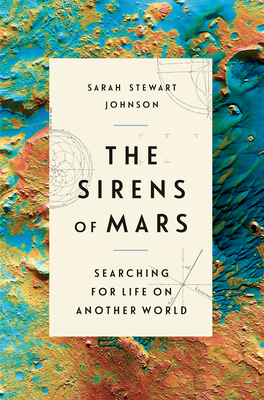Sarah Stewart Johnson grew up in Kentucky before becoming a planetary scientist. She now runs a research lab as a professor at Georgetown University and works on NASA missions. Her writing has appeared in the New Yorker, The New York Times, The Los Angeles Times, The Harvard Review, and the Best American Science and Nature Writing. Her book, The Sirens of Mars: Searching for Life on Another World, was selected as one of The New York Times's 100 Notable Books of 2020.

-
The Sirens of MarsSearching for Life on Another World
The precision of the map allowed Maria to read the planet’s history like a type of braille. As hinted by the initial data, the northern hemisphere proved to be the smoothest surface that had ever been observed in the solar system. Most of the terrain seemed to tilt slightly to the north, suggesting that a planetwide drainage system may have once emptied there, into a great northern ocean. Inscribed onto the surface was even a possible shoreline, Deuteronilus, which could be traced for thousands of kilometers. The coast ran along nearly the same elevation, with variations that could be explained by the ground rebounding, exhaling as the weight of a sea of long-gone water evaporated. With each new detail Maria plotted, another aspect of Mars’s history came to life.
Mars Global Surveyor changed what it meant to see a planet. If the old map of Mars was a simple picture, the new map was a portrait. It went beyond what our eyes could take in, capturing data on contours, on composition, on forces we could not see—not just topography but things like magnetic signals and mineral compositions measured out beyond the visible wavelengths. There were subtleties to be seen—we just had to get there, and when we got there, we had to know how to look.Excerpt(s) from The Sirens of Mars: Searching for Life on Another World by Sarah Stewart Johnson, copyright © 2020 by Sarah Stewart Johnson. Used by permission of Crown Books, an imprint of Random House, a division of Penguin Random House LLC. All rights reserved.
 The Sirens of Mars : Searching for Life on Another World
The Sirens of Mars : Searching for Life on Another World- Print Books
- Find your local bookstore (via IndieBound)
- Bookshop
-
The Sirens of MarsSearching for Life on Another World
ALH84001 was a glimpse into a future brimming with possibility. What if life on Mars was completely different from life on Earth? Every organism we knew, down at the molecular level, was just the same: DNA-based, with DNA coding for RNA, RNA coding for amino acids, amino acids coming together in proteins, and proteins building cells. What if those tiny Martian cells were built on an entirely different biochemistry? Perhaps the answers were inside a meteorite. Perhaps the rock would reveal the underlying constitutional nature of life—perhaps even evidence of a separate genesis. Or, if those cells bore fundamental similarities to life on Earth, it might suggest universal laws of biology, just as there were universal laws of physics and chemistry. In these ways, when ALH84001 fell to Earth, it had landed us on the brink of discoveries so profound that they promised to transform the very nature of science.
Excerpt(s) from The Sirens of Mars: Searching for Life on Another World by Sarah Stewart Johnson, copyright © 2020 by Sarah Stewart Johnson. Used by permission of Crown Books, an imprint of Random House, a division of Penguin Random House LLC. All rights reserved.
 The Sirens of Mars : Searching for Life on Another World
The Sirens of Mars : Searching for Life on Another World- Print Books
- Find your local bookstore (via IndieBound)
- Bookshop
-
The Sirens of MarsSearching for Life on Another World
Before the end of the mission, Mars Global Surveyor also took the first photograph of Earth from another planet. [...] I remember staring at that picture on my computer. I had searched for it, dragging the image to cover the screen, making it as large as I could. Earth seemed impossibly distant, but it was still recognizable. It was a crescent, more than half dark. The moon was next to us, with the same shadow.
As I peered at the pixels, trying to resolve the tiny squares of blue and green and white, I thought about where I was in the picture. In the frame, so much had been captured, and obscured. I was there somewhere, going about my life the day it was taken. I wondered if I’d been cooking a white-bean soup or sleeping in a rumpled bed when the shutter clicked, or gazing through the heavy glass window of the library at the rain outside. Perhaps I was sitting under a magnolia tree, or rushing across a crowded city street, midway through an infinitesimal step. Perhaps I was lost in thought somewhere, wondering if I had what it took to be a scientist, wondering who would show me the way.Excerpt(s) from The Sirens of Mars: Searching for Life on Another World by Sarah Stewart Johnson, copyright © 2020 by Sarah Stewart Johnson. Used by permission of Crown Books, an imprint of Random House, a division of Penguin Random House LLC. All rights reserved.
 The Sirens of Mars : Searching for Life on Another World
The Sirens of Mars : Searching for Life on Another World- Print Books
- Find your local bookstore (via IndieBound)
- Bookshop
“Lovely . . . . Johnson’s prose swirls with lyrical wonder, as varied and multihued as the apricot deserts, butterscotch skies and blue sunsets of Mars.” —Anthony Doerr, The New York Times Book Review [on The Sirens of Mars]
“The book is part memoir, part history, part education, and the three flow together so smoothly you might not even realize how much you are learning about Mars . . . . She manages to press moments in time together as closely as the sedimentary rocks on Mars, revealing its history just as the rocks do.” —Leah Crane, The New Scientist [on The Sirens of Mars]
“From the wrong turns and inspired breakthroughs of scientific discovery to Johnson’s own lifelong fascination with Mars, this is a book that will have even the staunchest earthlings looking in wonder towards the red glow above.” —The Daily Beast [on The Sirens of Mars]
Selected Works

- Print Books
- Find your local bookstore (via IndieBound)
- Bookshop
Though the subject of Sarah Stewart Johnson’s work is Mars, the life in her brilliantly realized book resides on earth – in our desire to populate the red planet, our disappointment at the failures of various missions, our persistence in returning to uncover its long-held secrets. Full of joy and existential curiosity, the book’s images and metaphors take up residence in our minds and burn there, connecting scientific inquiry with deep questions about human existence. In every line Johnson makes us feel the passion for discovery and the desire to connect.